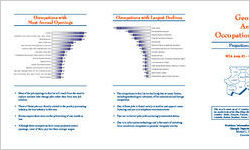Occupations with Most Annual Openings
Cashiers Textile Wind., Tw ist., & Draw . Out Mach. Setrs., Opers., & Tndrs.
Retail Salespersons Waiters & Waitresses Comb. Food Prep. & Serving Workers, Incl. Fast Food Laborers & Freight, Stock, & Material Movers, Hand Stock Clerks & Order Fillers Textile Knitting & Weaving Mach. Setters, Operators, & Tenders General & Operations Managers
Registered Nurses Customer Service Representatives Elementary School Teachers, Ex. Spec. Ed. Sales Reps., Wholesale & Manuf., Ex. Tech. & Scientific Products Extrud. & Form. Mach. Setrs., Opers., & Tndrs., Syn. & Gl. Fibers
Teacher Assistants
170 160 140 140 130 130 130 120 120
280 250 240
420 410 390
Most of the job openings in this list will result from the need to replace workers who change jobs rather than from new job creation.
Three of these jobs are directly related to the poultry processing industry, the key industry in this area.
Eleven require short-term on-the-job training of one month or less.
Although these occupations have many projected annual openings, most of them pay less than average wages.
Occupations with Largest Declines
-230
-150 -120 -110 -80 -80 -60 -50 -40 -40 -40 -40 -40 -30 -30
Order Clerks Sew ing Machine Operators Machine Feeders & Offbearers Prepress Technicians & Workers Dishw ashers Electrical & Electronic Equipment Assemblers Sw itchboard Operators, Incl. Answ ering Service Computer Operators Bindery Workers Dining Room & Cafe. Attendants & Bartender Helpers Loan Interview ers & Clerks Paper Goods Machine Setters, Operators, & Tenders Printing Machine Operators Meter Readers, Utilities Railroad Brake, Signal, & Sw itch Operators
The occupations in this list are declining due to many factors, including technological advances, office automation and foreign competition.
One of these jobs is found mainly in textiles and apparel manufacturing and one is in telephone communications.
Two are in clerical jobs with increasingly automated duties.
One is in information technology and is the result of switching from mainframe computers to personal computer servers.
Georgia Area
Occupational Trends
Projections to 2010
WIA Area #2 GA Mountains
This area is made up of 13 counties in northeast Georgia comprising the southern tip of the Blue Ridge Mountains. It includes the following counties: Banks, Dawson, Forsyth, Franklin, Habersham, Hall, Hart, Lumpkin, Rabun, Stephens, Towns, Union and White.
Workforce Information & Analysis Division Georgia Department of Labor Michael L. Thurmond Commissioner
Total employment in WIA Area #2 is expected to reach almost 240,000 jobs by the year 2010, with almost 5,500 new jobs added each year. The area's economy is currently among the fastest growing in Georgia, with expected job growth of 2.6 percent per year over the next ten years, as compared to 1.8 percent for the state.
Area Highlights
This area's main industry is poultry processing.
Its principal city, Gainesville, is aptly nicknamed "the poultry capital of the world."
It is the national leader in the production of broiler chickens and the third largest producer of chicken eggs.
This area contains two of the fastest growing counties, Forsyth and Dawson, in the United States. As such, it was among the fastest growing areas in Georgia from 1990 to 2000, experiencing a 48.5 percent increase in population, while Georgia overall saw an increase in population of 25.8 percent over the same period.
This area was also among the leaders in Georgia in the rate of growth in personal income, as it witnessed a 143.4 percent increase from 1990 to 2000 compared to a statewide growth rate of 98.2 percent.
For copies of the Georgia Career Planner, Georgia Occupational Trends in Brief
or this publication, call 404/232-3875 or contact your local
Department of Labor office.
Fastest Growing Occupations
Computer Softw are Engineers, Applications Computer Support Specialists Child Care Workers
Customer Service Representatives Maids & Housekeeping Cleaners Registered Nurses Accountants & Auditors Security Guards
Nursing Aides, Orderlies, & Attendants Electricians
Automotive Service Technicians & Mechanics Meat, Poultry, & Fish Cutters & Trimmers Receptionists & Information Clerks Cleaners of Vehicles & Equipment General & Operations Managers
5.8% 4.5% 4.3% 4.0% 4.0% 3.9% 3.9% 3.9% 3.7% 3.4% 3.4% 3.2% 3.1%
9.4% 8.2%
Occupations with Largest Job Growth
Retail Salespersons Cashiers
Customer Service Representatives General & Operations Managers Registered Nurses
Laborers & Freight, Stock, & Material Movers, Hand Office Clerks, General
Computer Support Specialists Maids & Housekeeping Cleaners Sales Reps., Wholesale & Manuf ., Ex. Tech. & Scientific Products Meat, Poultry, & Fish Cutters & Trimmers Janitors & Cleaners, Ex. Maids & Housekeeping Cleaners Nursing Aides, Orderlies, & Attendants Truck Drivers, Heavy & Tractor-Trailer
Teacher Assistants
1,410 1,320 1,300 1,190 1,060 960 780 760 760 740 730 640 630 630 620
These fast-growing occupations will have better employment prospects than occupations with slow or declining employment. Also, conditions will be more favorable for mobility and advancement.
The top two fastest growing occupations are associated with computer technology.
Four are found mainly in health services or are computerrelated.
Nine of these occupations do not require any formal education beyond high school.
These 150 occupations out of more than 700 - are projected to add more than 13,500 jobs over the next 10 years, about 25 percent of all projected job growth in this area.
Eleven occupations require short-term on-the-job training of one month or less and two require an associate's degree.
Seven of these occupations also appear in the chart of the fastest growing occupations.
Equal Opportunity Employer/Program Auxiliary Aids and Services Available upon Request to Individuals with Disabilities
